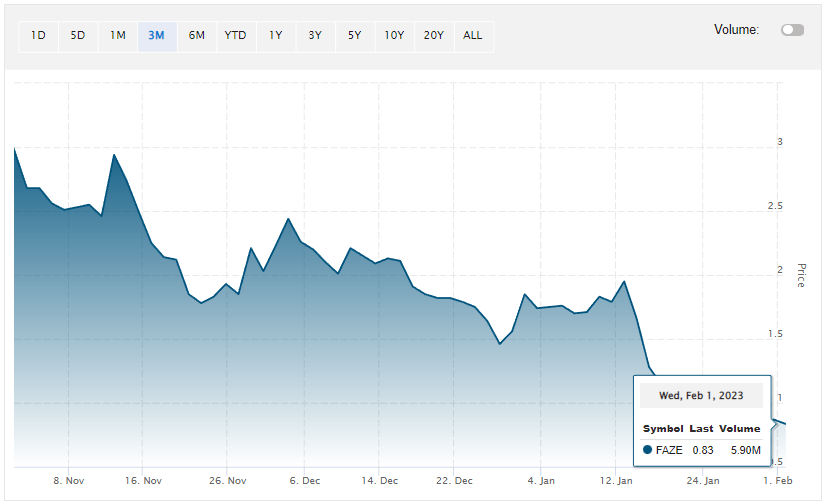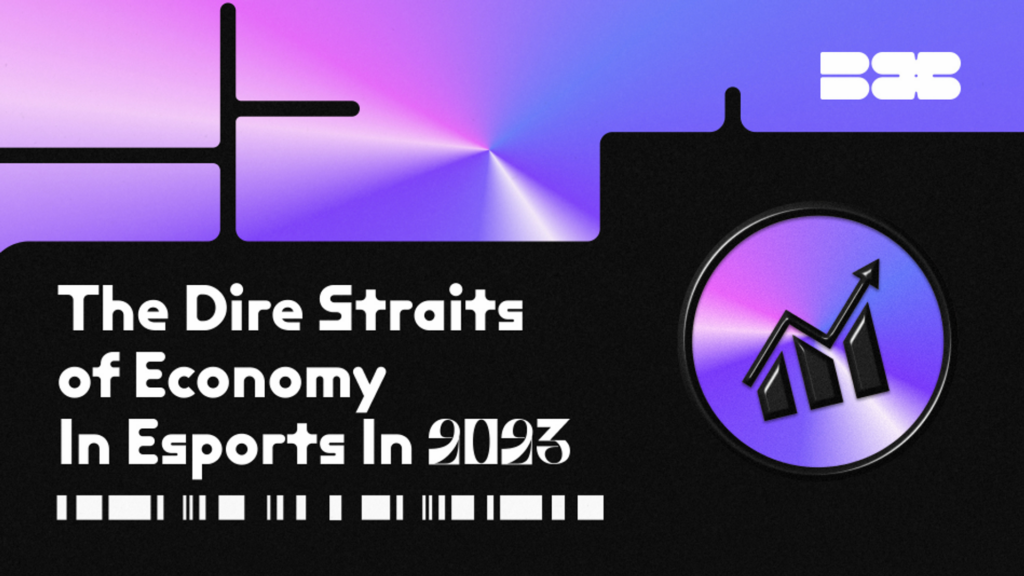While everyone was cooped up in their homes during the pandemic, esports was one of the few industries that thrived as it moved to the online era of competition. This also meant that the interest in esports was highly attainable as an entertainment product and gathered several new eyeballs. One thing that hasn’t changed was the nefarious attempts from organizations to milk every penny from sponsors to keep their heads above water. This brings us to the historical catastrophe that has been the adventure of Faze Clan’s SPAC (Special Purpose Acquisition Company) merger and the thrilling downhill journey on the Nasdaq. After the merger and the company went public under the ticker FAZE, the merger was initially valued at $1 billion, but when it went live, it was valued at $725 million (Source: investorplace). On January 4th, 2023, FAZE stocks were valued at $0.89, dropping below one dollar, which started a sea of questions about their actual value and the potential value of prominent organizations in esports, as it is one of the biggest actors in the space.

Source: Investorplace
This begs the question, how did we end here, and is the bubble bursting? As for the first question, it leads straight to:
Contents
The Venture Capital Era

Image: Pexels
The story begins in 2015, when owners or both, at that time, current and retired athletes, clubs, and wealthy people bought teams and slots in the different leagues in hopes of competing at the highest level and winning trophies internationally while also helping the teams with player development, nutrition, and sponsorships. The most famous example was Rick Fox buying Gravity Gaming’s League of Legends North American League of Legends Championship Series (LCS) spot in December of 2015 and founding Echo Fox. Afterward, expanding into Counter-Strike: Global Offensive, Street Fighter, and Smash Bros. Melee (Source: dotesports).
This trend continued with famous athletes, sports clubs, and especially VC funds pumping money into the industry, expecting big returns. This has led to the inflation of salaries, especially in League of Legends and Counter-Strike: Global Offensive, where this inflation was unrealistic at the time and still is unfeasible for organizations to attain from the natural revenue streams in esports.
The Nefarious Threeway Mexican Standoff

Image: Wikipedia
This has led to a three-way Mexican standoff between players, organizations, and sponsors. The players have many opportunities to offer their services to the organizations’ competitors, where they could get their desired salary. The inflated market incentivizes organizations to get the best players to achieve titles and sporting success. Then there is the trickery of the players agreeing to do different agreed-upon conditions that they didn’t necessarily keep to get the highest salary possible. As written earlier, organizations are incentivized to pay the players’ desired salary, which leaves them in a position of little power when it comes to negotiating these inflated salaries, which in turn leaves them to be creative when it comes to generating the income to uphold the business and still fight for titles.
This has come through trying to get more money from sponsors and, in some cases hosting skin betting sites and rigging the outcome, as seen in the catastrophe that was CSGO Wild, which was owned by Faze Clan’s owner Faze Banks, where he expressed on a podcast that his motivation was to buy a CS:GO team, and they ‘weren’t making enough money to buy a CSGO team,’ which would cost him about ‘a million dollars. (Source: Talkesport)
Also, the organizations have been focusing on getting the biggest talents and getting titles instead of creating a sustainable growth model and revenue streams to keep up with the market’s demand. Richard Lewis commented on this during the podcast The Four Horsemen when they discussed the economy
‘These orgs, they spend, they spend, they spend, massively overinflated player salaries, because they don’t want to create value in players, they don’t want to scout, they don’t want to be smart, they don’t want to get together and create an academy league or any of this stuff, they just want to have the best players. So you end up with like the Swordart deal at TSM, and he was absolute trash anyway. So they spend, and they spend and they spend, but they misrepresent their numbers all the time, our industry has had such a fucking problem with people throwing money at things that don’t exist. I don’t know many people who work in an esports org, that when it comes to full transparency about their numbers, they are just full of shit. And I’m talking about even owners I get along with, you’re full of shit. People who are on the middle tier management, full of shit. They are all full of shit. They all lie. All their numbers are garbage and then when people get wise to a number, they just invent a new metric entirely and say; no this was the most important one all along and everyone is full of shit about that.’
The final actor in this standoff was the sponsors, where the key merit and selling point were the core demographics of esports watchers. In 2018, the global fan base consisted of 37 percent young male adults ages 21 to 35 and 16 percent representing females ages 21 to 35. In addition, 61 percent of the United States esports viewers earned more than $50.000 a year (Source: deloitte)
This is a very lucrative market for sponsors, as these people will have many years of income and could be potential buyers of their products. The overwhelming amount of potential from the interest base in esports is based on the amount of youth and accessibility to the attention of this lucrative demographic. However, when esports doesn’t have a healthy and ergonomic method of generating sustainable income, a successful revenue stream and still overspend from the capital mentioned earlier, leads for the organizations to ask more money from the sponsors, which in return can disincentive these sponsors to add more capital to the space, which leads to the following question:
What Are The Spending Habits of Esports Fans?
 Cutting a One Dollar Bill with a Scissors | Copyright: © Corbis
Cutting a One Dollar Bill with a Scissors | Copyright: © CorbisEsports is still in an immature state, where they wish to become as big as regular sports, but have yet to implement successful revenue streams for the organizations and tournament organizers. Throughout history, esports has mostly been free to watch. This means that a classic revenue stream for sports has been neglected as esports grew to a bigger audience in two distinct eras, the rise in 2015 and during the pandemic of 2020.
A term called The Irrational Fear of Loss plays a part here for the tournament organizers that, by definition, means that the actor worries about losing things they are going to lose anyway, which in return makes them cling to them no matter the cost (Source: Psychology Today)
In this instance, the tournament organizers are scared of losing fans if they put up a paywall to watch tournaments, which in turn could potentially lose them sponsor money. Though it is healthy to diversify the portfolio, The Irrational Fear of Loss plays a big part here, where sound reason is traded for the highest viewing statistics on their broadcasts and narcissistic gloating when presenting these stats to the sponsors and the world.
With this clarified, another revenue stream has been shut down, primarily from the fans, for as petty a reason as not being able to use specific emotes in the chat. Two historic deals are worth mentioning.
Firstly, the ESL and Facebook media rights deal for an undisclosed amount. Dota 2 and Counter-Strike: Global Offensive would be broadcasted on Facebook Watch, their streaming-video component. This deal encompassed tournaments, recaps, highlights, and a week-in-review show (Source: Wired). The reaction from the fanbase was questioning why the deal wasn’t on Twitch. This was at the height of the VC-funded organizations spending like there was no tomorrow. Now that tomorrow has hit, the market is not in a position to capitalize on the overspending and leading to maybe bursting the esports bubble. The viewing experience was questionable, but after a short time, the fans reacted heavily to this experience and made it very clear that Facebook and their project were not a feature and platform the fanbase wanted, which made Facebook not invest much in deals like this in the future.
Over three years, the 2020 Activision and YouTube media rights deal was valued at $160M USD(Source: esports observer). The games to be featured were Overwatch, Call of Duty, and Hearthstone. The Overwatch League (OWL) peaked in its first season, views. YouTube does not have an easy, intuitive way of finding the broadcast. The significant decline in interest in the OWL is not something YouTube can be happy about, though the platform is objectively the better streaming platform, where they offer features such as instant rewind and uploads of VODs, which Twitch doesn’t contribute to the same extent. YouTube cannot be happy with this deal, which begs the question if they make the same kind of exclusive media deals in the future.
The esports fan base is at a point where they are used to getting great spectacles from the tournaments for free, which also is represented in the spending on merchandise. The Irrational Fear of Losing is at the point of tournament organizers like ESL not wanting to risk a $5 USD subscription to watch some of their flagship tournaments like ESL One Cologne or IEM Katowice. Even a proven successful method that OGN used in early League of Legends esports, where the audience could watch the games for free at a lower resolution and subscribe to watch the games in full resolution, has not been tried since it vanished after Riot took over the production of the Korean League of Legends league, that was renamed LCK and implemented franchising.
Today the major tournament organizers stream to both Twitch and YouTube so that the fans can watch the tournaments on their desired platform for free. Historically, the esports fan base has had an almost religious attachment to Twitch, where every media rights deal historically has been met with the question of why the tournaments aren’t broadcasted on Twitch, and then later, very vocally, expressing their disappointment, when the organizers have tried to secure media rights deals.
This leads to questioning where the money comes from to keep everything afloat:
Where does the money come from?

Image: Pexels
Bad actors with big wallets will find their way when a lucrative demographic in a growing and immature market happens in esports. Everything from states that infringe on human rights, through sportswashing, to bad actors in the crypto space and crypto casinos has been seen. Some have disappeared, and others have thrived. One of the big things was the Middle-Eastern states, primarily the United Arab Emirates and Saudi Arabia, investing large amounts into several of the biggest products, for which I have written an extensive report. This applies not only to tournament organizers but also organizations and news sites. One of these organizations is the Danish organization Astralis, which partnered with the online crypto casino Roobet in May 2022 (Source: MBN Media) Roobet didn’t have a Danish betting license, and through extensive backlash from the community, the deal was canceled after 24 hours. Danish tournament organizer BLAST, who was extensively featured in my previously linked report when they partnered up with the Abu Dhabi government’s initiative ADGaming, is partly owned by Vækstfonden, who is a Danish national fund that helps provide money to startups and other companies to give more work opportunities in Denmark. It is partly funded by the state and by tax-paying citizens As well as Saudi Arabia’s Savvy Gaming Group buying ESL and Faceit for a staggering $1.5B in early 2022 (Source: ESL and FACEIT sold to Saudi Arabian backed Savvy Gaming Group for $1.5 billion | Esports.gg)
Furthermore, there is the matter of the controversial betting sponsor 1xBet, the global sponsor for tournament organizers ESL and WePlay, and has sponsored events on the media site HLTV, in mid-January held their awards show named ‘HLTV Award Show 2022 by 1xBet’. There have been numerous articles highlighting the bad faith in which 1xBet operates, where the platform has been banned in Ukraine due to a supposedly ‘acting in interests’ of the Russian state (Source: Ukraine gambling regulator revokes 1xBet operating license due to Russian links ‘ 5 Star iGaming Media Regulation) In 2019, Premier League clubs Liverpool, Chelsea, and Tottenham, who have been accused of ‘whitewashing’ 1xbet’s reputation (Source: Exclusive: ESL and WePlay respond to criticism of their partnerships with controversial sponsor 1xbet, NetherRealm, and Bandai Namco cut ties with WePlay – Esports News UK (esports-news.co.uk) During an investigation into 1xbet in 2019, The Sunday Times found that the online gambling company promoted bets on children’s sports, advertising on illegal websites, including cockfighting live streams and a ‘pornhub casino’ with topless croupiers (Source: The Times UK)
Regarding HLTV, there have been several cases where it shows money coming from bad-faith actors or inciting conflicts of interest. Firstly, there was a conflict of interest when Better Collective bought the site in 2020; Better Collective owned 2,5% of shares in Astralis Group until 2021, per their disclosure This was highlighted by non-affiliated journalists Duncan ‘Thorin’ Shields and Richard Lewis on their Return of By The Numbers podcast. Another instance was the site promoting the skin gambling site CSGOFast, where the banners said: ‘Get Rich Fast.’ As well as 1xbet and the aforementioned award show.
With all of the overspending, misleading, and inflated market, this leads to the consequences. Here are some highlights:
The Consequences

Image: Clipartmax
In June of 2021, one of the biggest North American organizations, TSM, made what could be called the largest publicly disclosed esports sponsorship in history when they made a ten-year naming rights deal with cryptocurrency exchange FTX, worth $210 million (Source: Talk Esport) However, the day after the announcement, Riot Games forbid TSM to promote FTX and use their rebranded name in Valorant and League of Legends (Source: Talk Esport) In August of 2021, Riot then announced a seven-year naming rights sponsorship deal with FTX (Source: Dot Esports) after just two months prior forbidding TSM to promote the cryptocurrency exchange.
Another big North American organization, 100Thieves, landed in January 2020 a high-profile sponsorship with Cash App, where they made a 15.000 square-foot Cash App-branded compound in Los Angeles. The deal would end later that year, with the company actively searching for a new sponsor without success, which led to more than 20 layoffs at the company (Source: Business Insider) In January of 2023, 100 Thieves had more releases, roughly 30 according to The Jacob Wolf Report including but not limited to; marketing, human resources and their chief revenue officer, vice president of account management and integrated marketing, vice president of IT, and much more (Source: Jacob Wolf) With the tendencies we have seen in the first months of 2023, the bubble is looking to burst. While downsizing is an indicator of it, the companies and tournament organizers are fighting to stay alive. At the same time, the inflated market makes it seem impossible to acquire the players necessary to fight for and win titles.
2023 is looking like the year of the excellent esports downfall.



